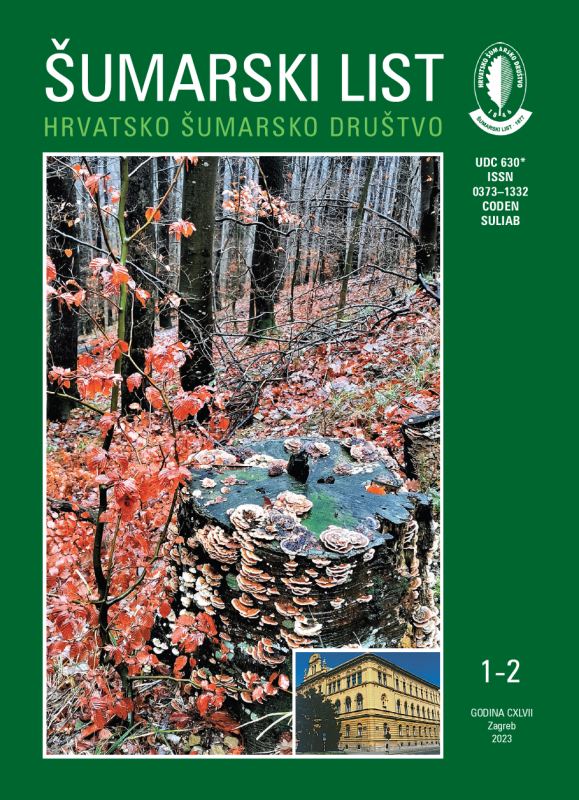
broj: 1-2/2023
pdf (8,7 MB) |
|
||||||||||||||
| RIJEČ UREDNIŠTVA | ||
| Uredništvo | ||
| How is the leased forestland used? pdf HR EN | 5 | |
| IZVORNI ZNANSTVENI ČLANCI | ||
| Ida Katičić Bogdan, Višnja Jurkić, Ivana Brlek, Marko Bačurin, Saša Bogdan | UDK 630* 165.+181.8 (001) https://doi.org/10.31298/sl.147.1-2.1 | |
| Genetic diversity of reproductive and phenological traits and their interrelationships in a clonal seed orchard of Wild Cherry (Prunus avium L.) pdf HR EN | 7 | |
| Krunoslav Teslak, Marijana Andabaka, Andrea Mertini, Karlo Beljan, Mislav Vedriš | UDK 630* 622+631 (001) https://doi.org/10.31298/sl.147.1-2.2 | |
| Choice of adaptive forest management model based on long-term projection in dinaric fir-beech stands pdf HR EN | 21 | |
| Summary Uneven-aged beech-fir forests cover approximately 157 000 hectares in Republic of Croatia. During the history they have been managed according to different management systems, varying from even-aged to selection management. As a result of historical integration of Croatian forestry into the German forestry school, alongside with unique ecological characteristics of Dinaric area, selection management system has been practiced in Croatia’s forestry ever since. Today, due to various reasons majority of beech-fir forests in Croatia have transitional structure between even-aged and selection structure. It is characterized by large growing stock, small increment, low vitality, poor fir regeneration and increasing share of beech. Example of such case is permanent experimental plot situated in Croatia’s north Dinaric area and managed by “Croatian forests” Ltd., which is a subject of this research. The aim of this research is to explore different annual cut models which will in future direct forest into stabile and optimal growth rate in selection structure with adequate volume share of fir. Input data have been acquired from successive measurements on permanent experimental plot in beech-fir stand. Tree growth simulator MOSES version 3.0 was tested for applicability in local conditions and has been used for projecting future stand‘s growth. Four scenarios based on different cutting models have been used to simulate possible types of future management emphasizing fir natural regeneration, establishment and maintenance of selection structure with targeted volume share of fir versus beech, and also supporting valuable broad-leaved species. All scenarios represent fir volume reduction followed by aggressive beech regeneration and partially accomplishment of selection structure in long-term. Thus, obtained different future stand structures were compared and ranked based on stand attributes and economic indicators. Annual cut based on decennial volume increment and stocking has been found best scenario from aspects of ecological, management and economic sustainability. Key words: beech-fir forests; growing stock; cut assessment; management model; MOSES tree growth model | ||
| Milica Marčeta, Ljiljana Keča, Stjepan Posavec, Sreten Jelić | UDK 630*901 (001) https://doi.org./10.31298/sl.147.1-2.3 | |
| Socio-economic characteristics of forestry companies in the Republic of Serbia pdf HR EN | 39 | |
| Mirzeta Memišević Hodžić, Dalibor Ballian | UDK 630* 164 (001) https://doi.org/10.31298/sl.147.1-2.4 | |
| Variability of leaf morphological traits of european black poplar and hybrid black poplars in the clone archive in Žepče pdf HR EN | 53 | |
| Mehmet Kalkan, Mustafa Yilmaz, Rasim Alper Oral | UDK 630* 164 (001) https://doi.org/10.31298/sl.147.1-2.5 | |
| The morphological and chemical variability of Turkish Hazel (Corylus colurna L.) fruits in Turkey pdf HR EN | 65 | |
| PREGLEDNI ČLANCI | ||
| Hubert Codrow, Anna Wierzbicka, Maciej Skorupski | UDK 630* 156 https://doi.org/10.31298/sl.147.1-2.6 | |
| Factors shaping teenagers and young adults’ approach to hunting : a review of the literature pdf HR EN | 75 | |


